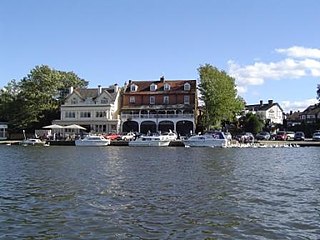
Elmbridge is a local government district with borough status in Surrey, England. Its council is based in Esher, and other notable towns and villages include Cobham, Walton-on-Thames, Weybridge and Molesey. The borough lies just outside the administrative boundary of Greater London, but is mostly within the M25 motorway which encircles London. Many of the borough's urban areas form part of the wider Greater London Built-up Area.
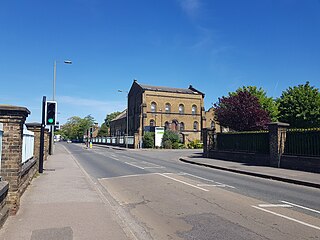
Seething Wells is a neighbourhood in southwest London on the border between Surbiton in the Royal Borough of Kingston upon Thames in Greater London, and Elmbridge in Surrey. The area was historically a waterworks that supplied London with water from the River Thames. Nowadays it is mainly a residential area, with the notable exception of decommissioned filter beds — the Seething Wells Filter Beds — in the northwest part of the area that borders the Thames.

Molesey is a suburban district comprising two villages, East Molesey and West Molesey, in the Borough of Elmbridge, Surrey, England, and is situated on the south bank of the River Thames.

The Metropolitan Water Board was a municipal body formed in 1903 to manage the water supply in London, UK. The members of the board were nominated by the local authorities within its area of supply. In 1904 it took over the water supply functions from the eight private water companies which had previously supplied water to residents of London. The board oversaw a significant expansion of London's water supply infrastructure, building several new reservoirs and water treatment works.

Molesey Lock is a lock on the River Thames in England at East Molesey, Surrey on the right bank.

The Staines Reservoirs are two large pumped storage reservoirs sitting to the east of the King George VI Reservoir near Heathrow airport in Surrey within the Colne Valley regional park. The village of Stanwell is mainly to the north east, and the town of Staines is to the south.
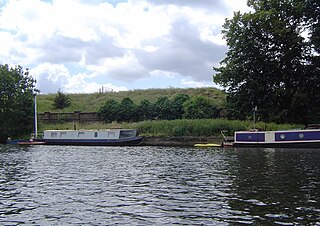
The Molesey Reservoirs were a group of reservoirs in England near Molesey, Surrey, in the western suburbs of London. There was an adjacent water treatment works.

The Stain Hill Reservoirs in London, England with embankments occupy 0.175 square kilometres. They are a pair which sit high between others; Kempton Nature Reserve; riverside houses in Sunbury-on-Thames; and a low area of flood meadow to the west alongside the closing stretch of the Port Lane Brook. Other nearby settlements are Molesey, Hampton and Hanworth.

The Bessborough Reservoir is an embanked storage reservoir south of the River Thames in Surrey adjacent to the Knight Reservoir. To the south lies Queen Elizabeth II Reservoir and to the north the now disused Molesey Reservoirs. The A3050 runs to the north of the reservoir and the neighbouring town is Molesey to the east. It forms part the green buffer between Molesey and Walton on Thames. The reservoir is in the borough of Elmbridge.

The Island Barn Reservoir lies south of the River Thames in England at West Molesey and north of Lower Green, Esher. The reservoir has a surface area of 122 acres (0.49 km2) and a capacity of 922 million gallons. Managed by Thames Water, it is in the Borough of Elmbridge and is surrounded by the River Mole to the west and the River Ember to the east. Queen Elizabeth II Reservoir is a larger reservoir to the West.
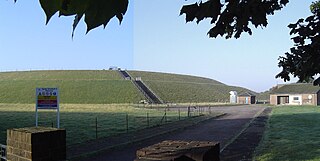
The Queen Elizabeth II Reservoir lies to the south of the River Thames and to the west of the Island Barn Reservoir. To the north are the Bessborough and Knight reservoirs. The A3050 runs to the north of the reservoir and it is situated in Walton on Thames. It is managed by Thames Water.
Sunnyside Reservoir is a reservoir forming part of the Hampton waterworks complex within the London borough of Richmond-upon-Thames.

London's water supply infrastructure has developed over the centuries in line with the expansion of London.
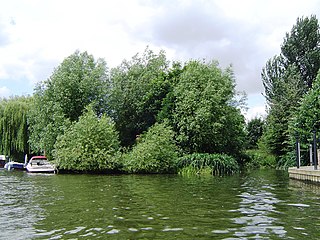
Grand Junction Isle is a small island in the River Thames on the reach above Molesey Lock at Sunbury-on-Thames, Surrey, England. It is just downstream of Sunbury Court Island, which is three times longer and also close to the north bank.
The Southwark and Vauxhall Waterworks Company was a utility company supplying water to parts of south London in England. The company was formed by the merger of the Southwark and Vauxhall water companies in 1845 and became part of the publicly owned Metropolitan Water Board in 1904.
The Lambeth Waterworks Company was a utility company supplying water to parts of south London in England. The company was established in 1785 with works in north Lambeth and became part of the publicly owned Metropolitan Water Board in 1904.
The West Middlesex Waterworks Company was a utility company supplying water to parts of west London in England. The company was established in 1806 with works at Hammersmith and became part of the publicly owned Metropolitan Water Board in 1904.
The Walton water treatment works are an advanced purification works supplied with raw water and producing and delivering potable water to the locality and into the Thames Water ring main. The Walton water treatment works were initially built in 1907 north of the Bessborough and Knight reservoirs which supply the water works.
The Kempton Park water treatment works, in the London Borough of Hounslow and Kempton Park Surrey, takes raw settled water abstracted from the River Thames and supplies treated potable water to consumers in north and west London. The works were inaugurated in 1906 and continue to provide treated water.

Hampton Water Treatment Works are water treatment works located on the River Thames in Hampton, London. Built in the second half of the 19th Century to supply London with fresh water, the Waterworks was in the past a significant local employer, and its brick pumphouses dominate the local landscape. The Waterworks are currently owned and operated by Thames Water, occupying a 66 ha site located between the Upper Sunbury Road (A308) and the River Thames. The Waterworks currently has a maximum output of 700 megalitres a day, and supplies ~30% of London's fresh water.

















